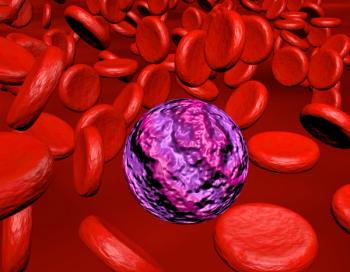
- Oncology Vol 29 No 4_Suppl_1
- Volume 29
- Issue 4_Suppl_1
(S003) Weekly IGRT Volumetric Response Analysis as a Predictive Tool for Locoregional Control in Head and Neck Cancer Radiotherapy
Assessment of volumetric IGRT disease response for HNSCC that is treated with definitive CRT is valuable for predicting disease control. Patients with less than 70% volume reduction should be considered for early surgical intervention.
Raj Davuluri, MD, Jeff Krase, PharmD, Michael K. Cheung, MD, Brian N. Allen, MS, Sun K. Yi, MD; Department of Radiation Oncology, University of Arizona Cancer Center
INTRODUCTION: Organ-preserving chemoradiation (CRT) has become standard of care for head and neck squamous cell carcinoma (HNSCC). Volumetric image-guided radiotherapy (IGRT), though primarily utilized for daily setup precision, may also allow for treating physicians to evaluate disease response throughout therapy. In other disease sites, such as lung, IGRT-measured tumor response has been found to be predictive of oncologic outcome. To our knowledge, no such study has been performed in patients treated for HNSCC.
METHODS: After institutional review board (IRB) approval, patients who were treated definitively with CRT for stage III–IV HNSCC on TomoTherapy (Madison, WI) with daily megavoltage cone-beam computed tomography (MVCT) IGRT were retrospectively reviewed for volumetric response. A resident physician (RD), alongside an expert HN radiation oncologist (SY), contoured identifiable disease on representative weekly imaging while blinded to patient outcome. Response was measured against formal posttreatment clinical, radiological, and/or histological assessment. Data were stratified according to primary site or largest nodal disease. Student t-test was utilized to compare percent volume reduction in those with recurrence vs those without recurrence.
RESULTS: Thirty-five patients were identified with a median follow-up of 15.8 months. Fifty-six percent of patients were HPV-positive, and 67% was oropharyngeal, 12% was laryngeal, 9% was hypopharyngeal, and 6% was nasopharyngeal in origin. Twenty-six percent of patients were T4, 26% was T3, 21% was T2, and 17% was T1. Twelve percent of patients were N3, 65% was N2, 6% was N1, and 11% was N0. Eighty-five percent of patients had stage IV disease, and 15% had stage III disease. The median dose to gross disease was 70 Gy in 35 fractions. A total of 6 recurrences at a median follow-up of 8 months [range: ] were identified. Mean percent volume of disease at the end of treatment for those with recurrence vs those without recurrence was significantly different (31% vs 6%; P = .001). For primary tumors, the difference in mean residual disease was 20% vs 5% (P = .005) for recurrences vs nonrecurrences, respectively. For nodal disease, the difference in mean residual disease was 47% vs 6% (P = .0001) for recurrences vs nonrecurrences, respectively. When percent residual disease was less than 30% of original volume, the positive predictive value, negative predictive value, sensitivity, and specificity were 100%, 93%, 66%, and 100%, respectively.
CONCLUSIONS: Assessment of volumetric IGRT disease response for HNSCC that is treated with definitive CRT is valuable for predicting disease control. Patients with less than 70% volume reduction should be considered for early surgical intervention.
Proceedings of the 97th Annual Meeting of the American Radium Society -
Articles in this issue
Newsletter
Stay up to date on recent advances in the multidisciplinary approach to cancer.


















































































